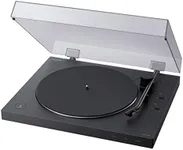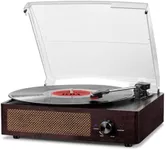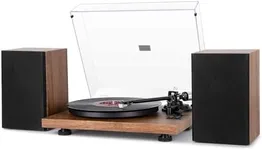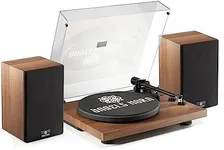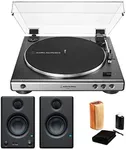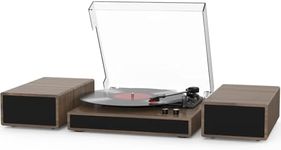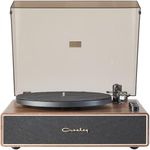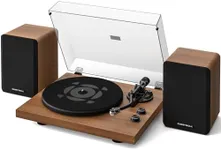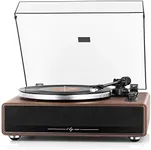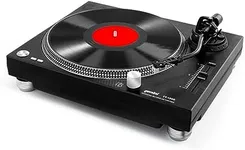Buying Guide for the Best Turntable With Speakers
Choosing the right turntable with speakers can greatly enhance your music listening experience. It's important to consider various specifications to ensure you get the best fit for your needs. Understanding these key specs will help you make an informed decision and enjoy your vinyl records to the fullest.Drive TypeThe drive type refers to how the turntable's platter is powered. There are two main types: belt-drive and direct-drive. Belt-drive turntables use an elastic belt to spin the platter, which helps reduce motor noise and vibration, making them ideal for home listening. Direct-drive turntables have the motor directly connected to the platter, providing more consistent speed and torque, which is preferred by DJs for scratching and mixing. If you are a casual listener, a belt-drive turntable might be the best choice. If you plan to use the turntable for DJing, a direct-drive model would be more suitable.
Cartridge TypeThe cartridge is the component that holds the stylus (needle) and converts the grooves on the record into an audio signal. There are two main types: moving magnet (MM) and moving coil (MC). MM cartridges are more common, easier to replace, and generally more affordable, making them a good choice for most users. MC cartridges offer higher fidelity and are preferred by audiophiles, but they are more expensive and require a compatible phono preamp. Consider an MM cartridge if you are new to vinyl or want a hassle-free experience. Opt for an MC cartridge if you are seeking the highest sound quality and are willing to invest in additional equipment.
Built-in PreampA built-in preamp amplifies the signal from the turntable to a level that can be used by speakers or other audio equipment. Some turntables come with a built-in preamp, while others require an external one. A built-in preamp simplifies setup and is convenient for beginners or those with limited space. However, external preamps often provide better sound quality and more customization options. If you want a straightforward setup, choose a turntable with a built-in preamp. If you are an audiophile or plan to upgrade your audio system, consider a turntable without a built-in preamp and invest in a high-quality external preamp.
Speed SettingsTurntables typically support different speed settings to accommodate various types of records. The most common speeds are 33 1/3 RPM (revolutions per minute) for LPs and 45 RPM for singles. Some turntables also support 78 RPM for older records. It's important to choose a turntable that supports the speeds of the records you own or plan to buy. If you primarily listen to modern LPs and singles, a turntable with 33 1/3 and 45 RPM settings will suffice. If you have a collection of vintage 78 RPM records, ensure the turntable can accommodate this speed as well.
Speaker QualityThe quality of the built-in speakers can greatly affect your listening experience. Look for turntables with speakers that offer clear, balanced sound and good volume levels. Some turntables come with detachable or external speakers, which can provide better sound quality and more flexibility in placement. If you are an audiophile or want the best possible sound, consider a turntable with high-quality external speakers. For casual listening or limited space, built-in speakers may be sufficient, but ensure they meet your sound quality expectations.
Portability and DesignPortability and design are important factors, especially if you plan to move the turntable frequently or if aesthetics are a priority. Some turntables are designed to be compact and lightweight, making them easy to transport. Others have a more robust build and may include features like dust covers and anti-skate mechanisms. Consider a portable turntable if you need something easy to move or if you have limited space. If you prioritize sound quality and durability, a more substantial design with additional features may be a better fit.
